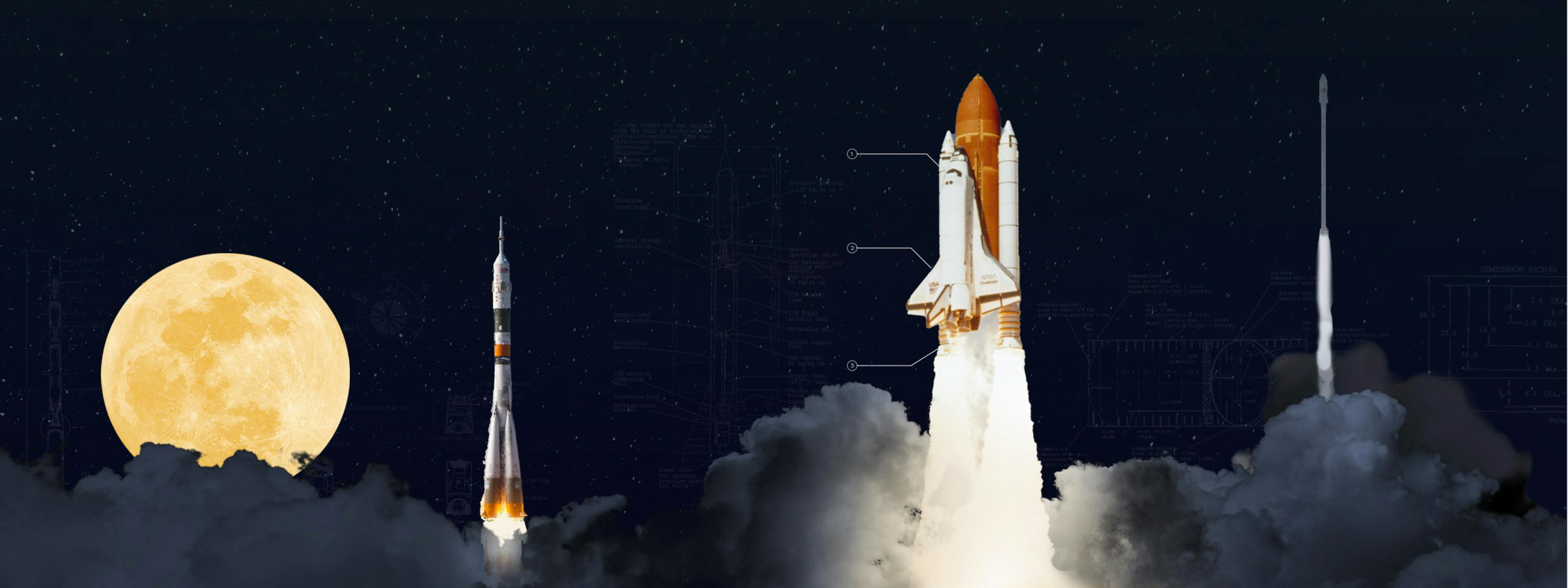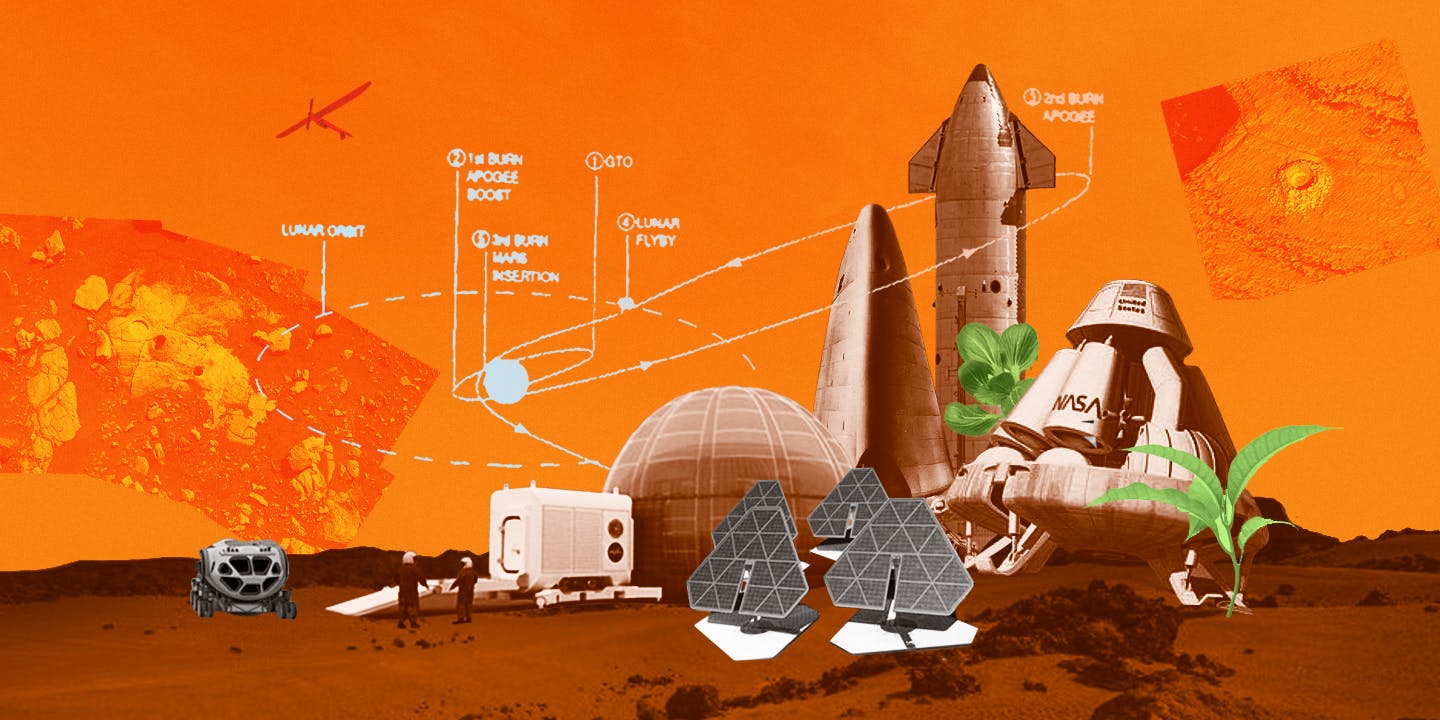Thesis
Ever since SpaceX landed its first rocket in 2008 and became the first privately funded liquid-fueled rocket company to reach orbit, a new space race had begun. This time, it was not between countries, as we saw in the Cold War, but between private companies. In 1958, when President Eisenhower founded the National Aeronautics and Space Administration, only military and civil contracts were being signed. Demand for transporting payloads to lower earth orbit (LEO) and geostationary earth orbit (GEO) has risen, especially as prices per kg keep getting lower. Space startups raised $14.5 billion from private investors in 2021, a 50% increase from 2020. In the past, launching a satellite would cost around $200 million. Through reusable rockets, it is possible to launch a satellite with $60 million. Mass production of satellites could reduce the cost from $500 million per satellite to $500K.
The market for LEO missions is expected to grow to $312 billion by 2035 due to increasing demand and technological advances on the supply side. Manufacturing and launch services are expected to drive the growth in the value chain of the space economy from $70 billion in 2022 to $100 billion by 2031. Historically, building a rocket has been complicated, with space companies working with thousands of suppliers around different parts of the globe to build individual parts. These parts are later put together in one place, increasing production costs and time.
Relativity Space is an aerospace company that designs, develops, and builds 3D-printed rockets. Its goal is to automate the rocket manufacturing process, reduce the number of parts in a rocket, build a launchable rocket in two months, and sustain Martian colonies using methane as rocket fuel. By building in-house rockets, Relativity Space aspires to achieve flexibility and automation while advancing research and development through rapid iteration. In March 2023, Relativity Space became the first company in the West to launch a methane-fueled rocket past the Kerman Line (100 kilometers in altitude) and the first 3D-printed rocket to support the point of maximum stress on the rocket.
Founding Story
Relativity Space was founded by Tim Ellis (CEO) and Jordan Noon (ex-CTO) in Los Angeles, California, in 2015, when Ellis was 22 and Noon was 26.
Ellis received bachelor's and master's degrees in aerospace engineering at the University of Southern California. He had originally wanted to study screenwriting but switched to aerospace engineering during his freshman orientation. He then joined the University’s Rocket Propulsion Laboratory, where he met Noon. Ellis worked with propulsion systems and metal 3D printing at Blue Origin. Ellis is also part of the National Space Council Users Advisory Group at The White House.
Noon interned at Blue Origin and worked on propulsion systems for Dragon 2, the capsule that would later carry astronauts to the International Space Station, during his time at SpaceX. He was the chief engineer and operating officer of the Rocket Propulsion Lab at the University of Southern California, the first student group to launch a rocket into space. Noon also became the first student to obtain an FAA launch license to launch a rocket to space. As of April 2023, Noon was the co-founder of Relativity Space, KittyCAD, and Embedded Ventures.
Both had worked on 3D-printed rocket parts and shared a vision for creating 3D-printed rockets. They participated in YC in 2016. The first version of Relativity Space’s rocket, Terran 1, was designed for smaller payloads and competed with ride-share missions on larger rockets.
Product
Terran 1
Terran 1 is Relativity Space's first rocket for constellation deployment and supply missions. The two-stage, expendable rocket has a dedicated mission cost of $12 million and can carry payloads of up to ~2.8K lbs to LEO, resulting in a price per kg for LEO missions of $9.6K. It uses nine 3D-printed Aeon 1 engines for the first stage and one 3D-printed Aeon Vac engine for the second stage.
Terran 1 is powered by liquid oxygen and liquid natural gas, two components that should be possible to produce on Mars. Terran 1 is 85% 3D-printed, and the company aims to increase the percentage of 3D-printed mass to 95%. Clients can have their payload launched within 30 days from payload ingress into the airlock.
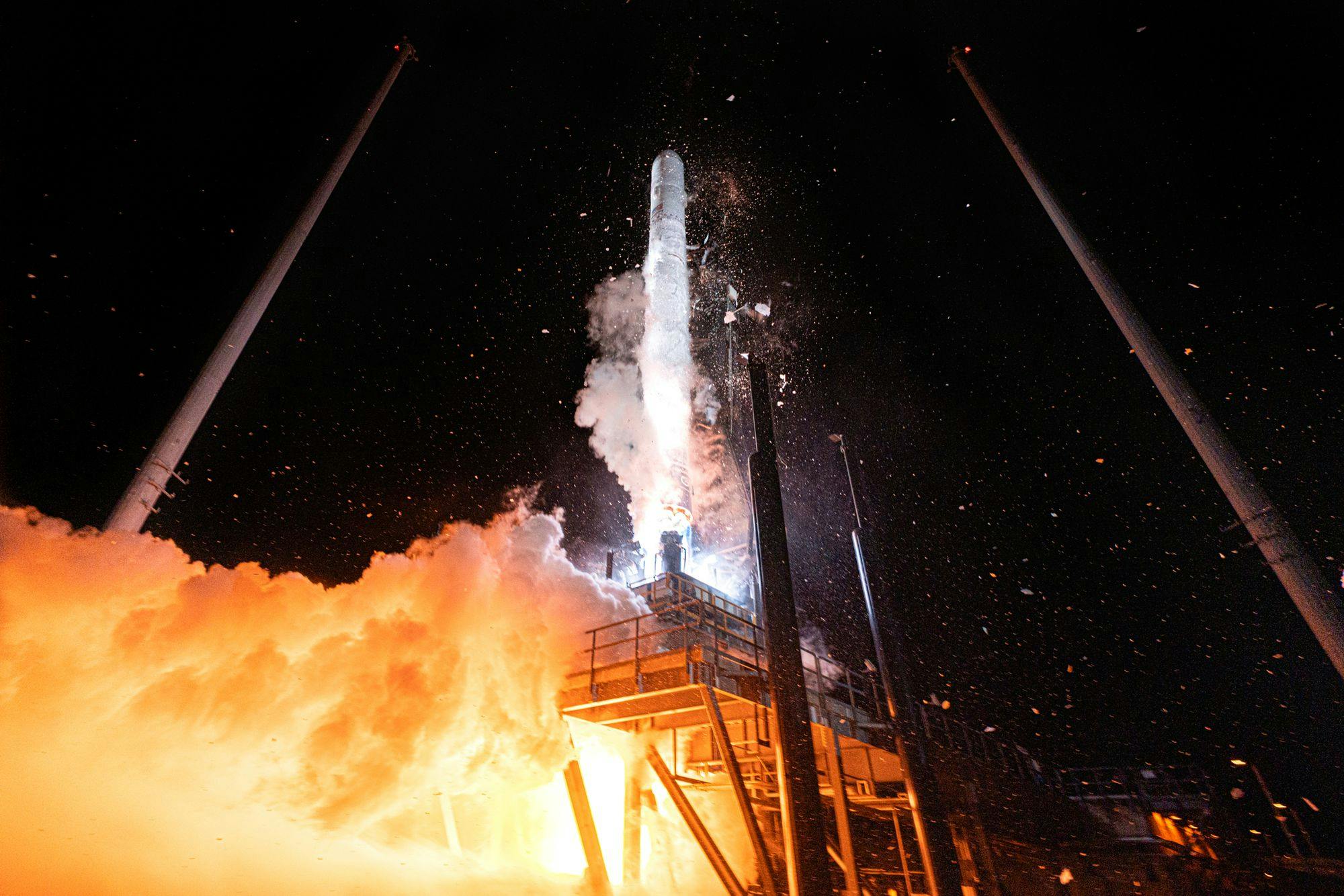
Source: Trevor Mahlmann
Terran R
In 2026, Relativity Space plans to launch Terran R, its biggest project, from Cape Canaveral. The Terran R is designed to carry payloads of up to 23.5K kg to LEO for interplanetary missions to Mars and the Moon. In April 2023, Relativity Space modified Terran R to more quickly meet what the company described as “overwhelming market demand”. The new version of Terran R will reuse only its first stage, abandoning full reusability. It will also use a combination of 3D-printed parts and parts that are not 3D-printed. Its first stage features 13 Aeron R engines, while its second stage has one Aeron Vac engine. Both stages use liquid oxygen and methane as fuel. The design of Terran R aims to optimize aerodynamics through data and software-driven manufacturing processes, with the goal of extending mission life beyond 20 reusable flights. Relativity Space will manufacture Terran R in Long Beach, California, using its fourth-generation Stargate 3D printer.
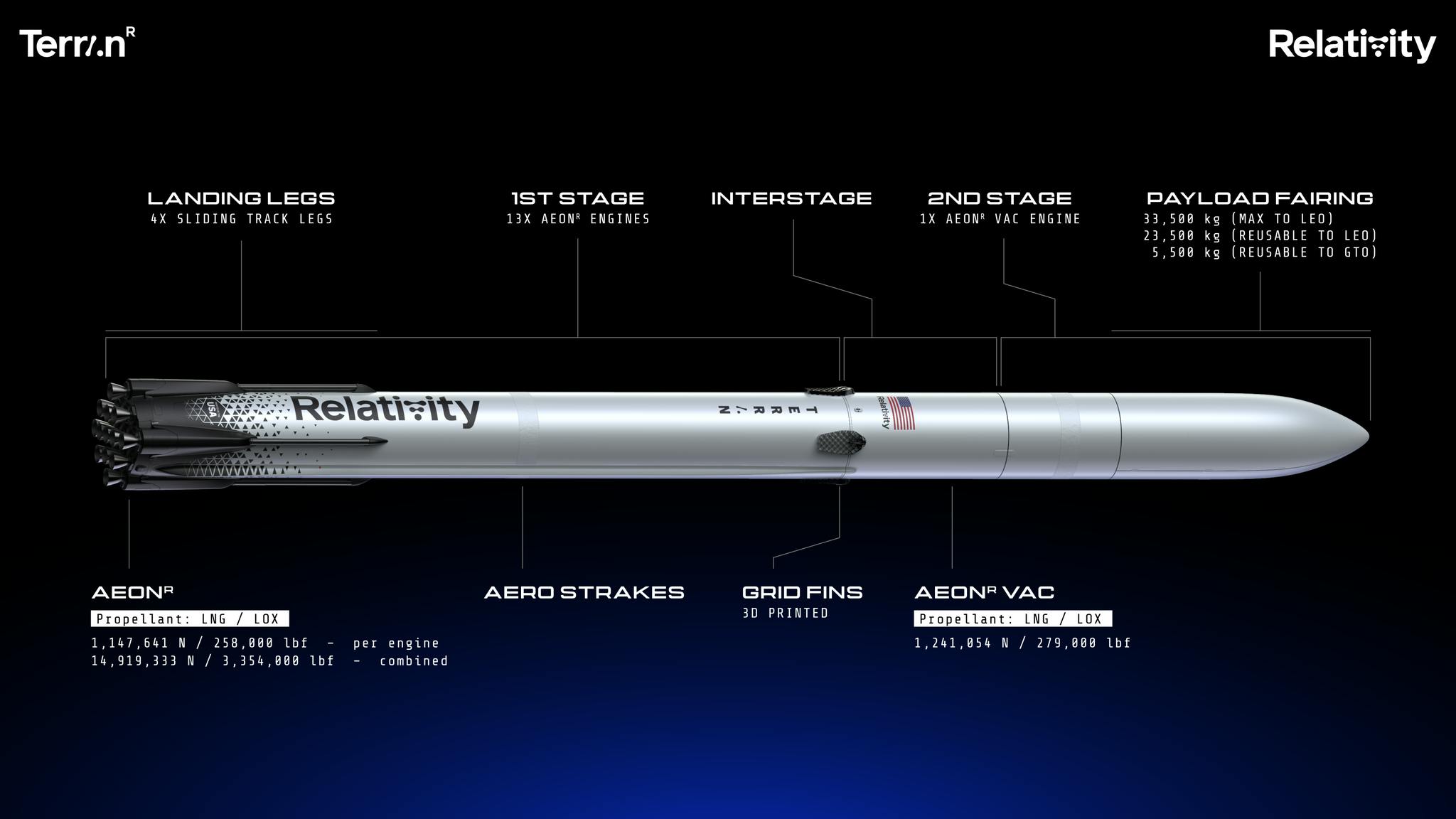
Source: Relativity Space
Aeon 1, Aeon R, Aeon Vac
Aeon 1, Aeon R, and Aeon Vac are 3D-printed engines that use liquid oxygen and liquid natural gas. These fuels are chosen because they are likely to be the easiest to make on Mars.
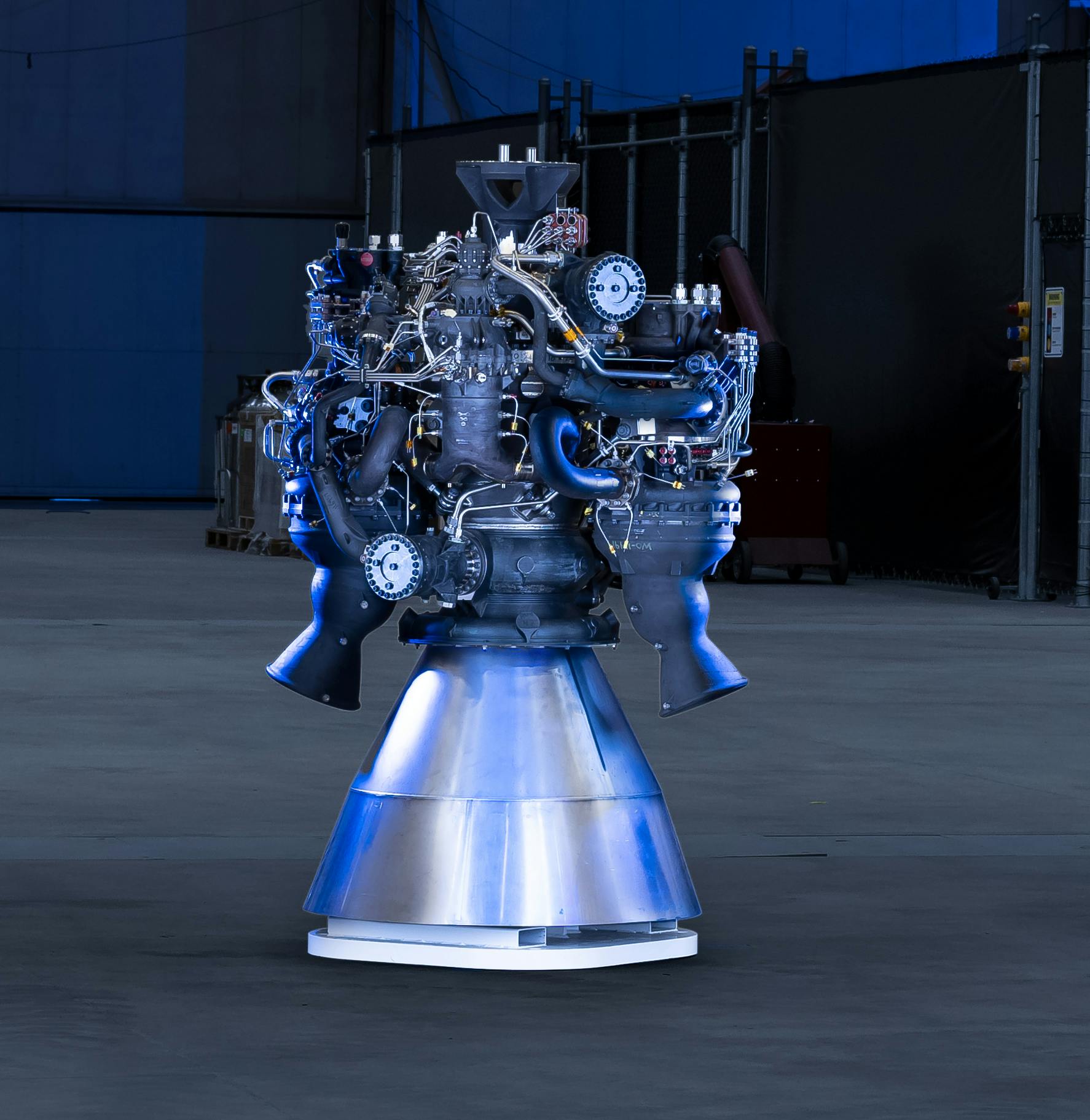
Source: Realtivty Space
Stargate
Stargate is a metal 3D printer for aerospace applications. It allows Relativity Space to build a rocket in 60 days, which will allow production to take place without involving complex supply chains and, according to the company, reduce part counts by 100x. Stargate can automate the process of production and iterate through different product versions faster. Stargate utilizes proprietary materials with high strength and physical properties designed to meet mission requirements. The printer uses AI to create real-time quality control and inspection, making it possible to produce complex aerospace parts with unique geometries. Stargate was used to produce 85% of Terran 1 and will produce almost 95% of Terran R in the future if the company’s estimates are accurate.
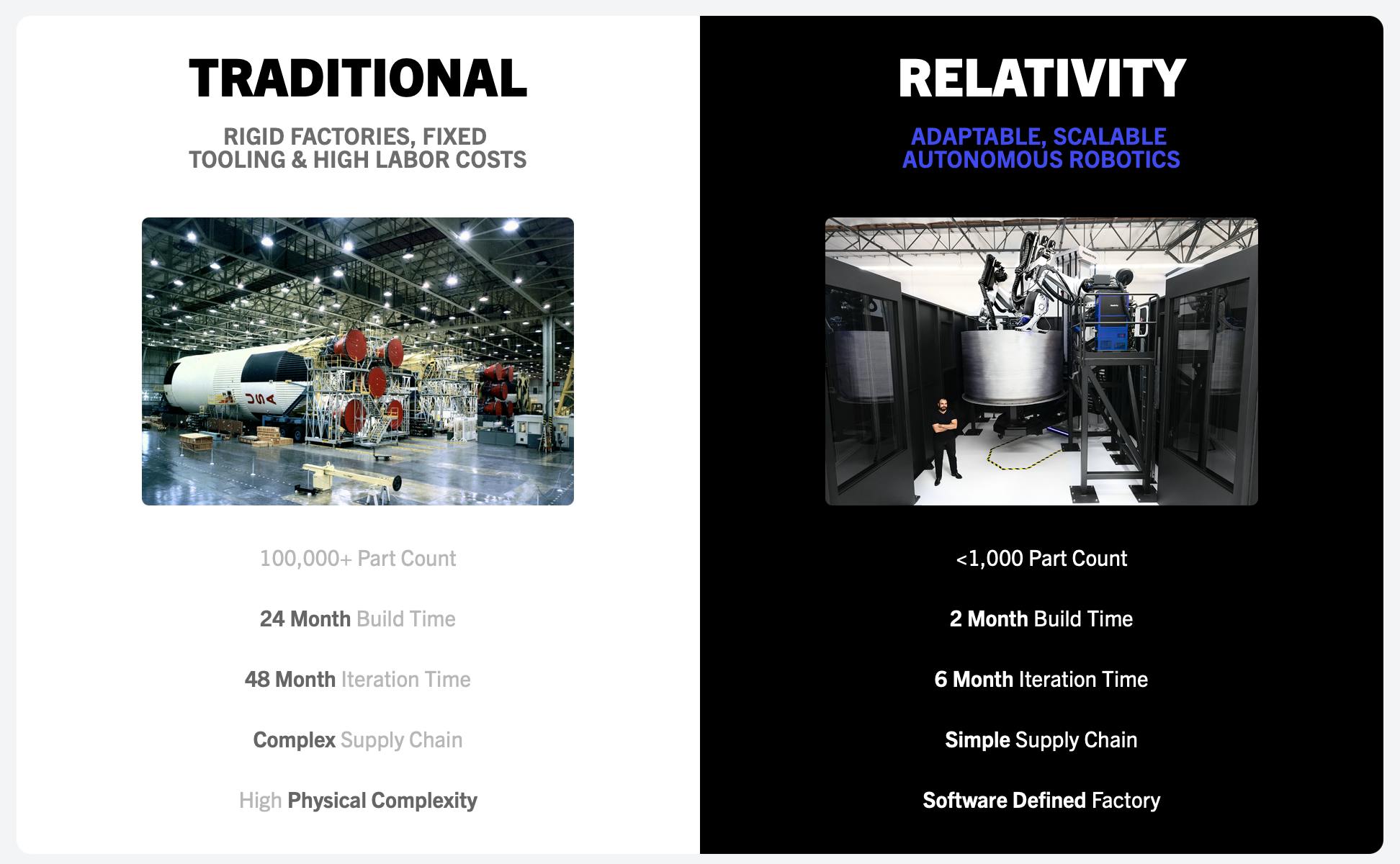
Source: Realtivty Space
Market
Customer
Customers for space launch services can be categorized into three main types: commercial, which typically involves companies working with navigation or communications satellites; government or civil, such as NASA or the US government; and defense, which includes the Department of Defense. Relativity Space's notable clients include OneWeb and Telesat, Lockheed Martin, the US Space Force, the US DoD, the US Air Force, and NASA.
Market Size
The market for launch services can be separated into two types: launch service providers for lower Earth orbit, and services for geostationary orbit. Relativity Space aims to provide launch services with Terran 1 for small payloads that want to reach LEO or sun-synchronous orbit (SSO). The development of Terran R will help the company enter the launching market for GEO and interplanetary missions. In 2022, the market for launch services was valued at $16.9 billion, and it is expected to grow to $29.6 billion by 2027.
Competition
SpaceX: SpaceX was founded in 2002. In 2008, after two years of failing to launch a rocket successfully, the company became the first privately-funded company to launch a liquid-propelled rocket. After its first successful launch, SpaceX developed the first reusable rocket, the Falcon 9. Besides sending satellites and supply missions to the ISS, the Falcon 9 has sent astronauts to the ISS with their Dragon capsule. SpaceX also launched the Falcon Heavy, one of the most capable rockets and the cheapest launch service at $1.4K per kg. Starship is SpaceX’s most ambitious project, which aims to build a fully reusable rocket for Lunar and Martian missions. As of March 2023, SpaceX has raised $9.8 billion in funding.
Rocket Lab: Rocket Lab is another space company that builds rockets and was founded in 2006. It had completed 35 launches as of April 2023. Rocket Lab offers clients a program called Responsive Space Program, which can send payloads to space 24 hours after the arrival of the payload. The company is also developing a bigger reusable rocket called Neutron to compete with SpaceX. It’s aiming for $50 million per launch and expects to launch in 2024. In August 2021 Rocket Lab had its IPO through a SPAC merger deal. As of April 4, 2023, Rocket Lab’s stock price sits at $4, coming down from an all-time high in September 2023 of $18.9. Its market valuation at IPO was $4.1 billion, and on March 4, 2023, it was at $1.9 billion.
Blue Origin: Blue Origin was founded by Jeff Bezos, founder of Amazon, in September 2000. Blue Origin's mission is to build reusable rockets to increase space accessibility through low-cost launches for space exploration. New Shepard is Blue Origin’s first and only flown reusable rocket as of April 2023; this rocket is limited to suborbital spaceflights and has completed 22 missions. Blue Origin offers people a seat to space aboard the New Shepard for $200K. The company is also developing two more products, the New Glenn, an orbital spaceflight rocket, and Blue Moon, a moon lander carrying payloads and crew to the moon. New Glenn is expected to launch by late 2024 and will serve both crewed and non-crewed missions. Its lunar lander, which competes with SpaceX’s, is scheduled for a test mission to the moon in 2024.
Astra: Astra is a space rocket launching service company founded in 2016. It provides dedicated, low-cost orbital launches for small satellites of up to 600 kg. After the failures of Astra’s Rocket 3.3, the company retired the vehicle and replaced it with their newest rocket, Rocket 4.0, which costs ~$4 million per launch. Astra also builds electric propulsion systems for in-space navigation for satellites. In 2021, Astra went public through a SPAC deal at a $2.1 billion valuation. In April 2023, Astra’s market valuation was ~$109 million.
ULA: ULA was founded in 2005 as a joint venture between The Boeing Company and Lockheed Martin. The company has successfully delivered non-reusable rockets for more than 150 missions. ULA has also sent a crew member to the ISS with Boeing’s Starliner capsule attached to ULA’s Atlas V rocket. Atlas V can carry up to 18K kg to LEO at $109 million per launch. ULA is also preparing the release of Vulcan, its newest vehicle. The Vulcan can take a payload of 10K kg to LEO, which is predicted to launch on May 2023.
Spin Launch: Spin Launch is a space startup founded in 2014. The company has raised over $146 million in funding and is building a space catapult that spins and hurls rockets into space, making payload transport cheaper and more sustainable. The company is still in the early trials of its suborbital accelerator and is expected to launch in 2025. Spin Launch costs $2.5K per kg with a limited payload weight of 200kg.
Business Model
Relativity Space has two main types of contracts. The first is a payload transport contract, which is valued based on the weight of the payload and the transport vehicle used. The second type of contract is a 3D printing contract, in which the company uses Stargate to build custom parts for clients, such as the US Air Force. The price per kg for Terran 1 is estimated to be around $9.6K, as per a NASA contract.
Traction
Relativity Space showed some early traction in 2016 when it entered Y Combinator. It had already closed $81 million in letters of intent for satellite companies aboard its Terran 1 rocket, which was then just a 3D model on a computer. In 2021, Relativity Space signed a contract with the US Department of Defense with a ceiling value of $986 million. Relativity Space also has a $5 million contract and a $12 million contract with the US DoD. As of April 2023, Relativity Space has collected over $2.9 million in civil and military contracts. Terran 1 also has contracts with private companies whose values are undisclosed. Companies that have signed contracts include Lockheed Martin, Iridium, Momentus, Spaceflight, and Telesat. In June 2022, Relativity Space announced that Terran R has a contract that will send OneWeb's second-generation broadband constellation in 20 launches at a contract value of $1.2 billion.
Valuation
As of April 2023, Relativity Space has raised $1.6 billion in funding from investors such as BlackRock, Sand Hill Angels, Mark Cuban, Tiger Global, Fidelity, Lux Capital, and Y Combinator. In June 2021, Relativity Space announced Series E of $650 million at a $4.2 billion valuation. Fidelity marked down its holdings of their Series D shares by 21% in May 2022.
Although some of Relativity Space's competitors have bigger valuations, with SpaceX for example valued at $127 billion in May 2022, space launch service companies have been less highly valued in the public market. For instance, Rocket Lab was valued at in April 2023 $1.8 billion, while Astra had a market valuation of $109 million.
Key Opportunities
Colonizing Mars
If Relativity Space can set up factories on Mars through its autonomous rocket factories, it would enable Martian colonies to build rockets to fly back to Earth or explore new frontiers. One significant challenge that Martian colonies will eventually face is their capability to produce fuel for return missions. Relativity Space's Aeon engines use liquid oxygen and natural gas, which can be produced on Mars. With autonomous factories and easy access to rocket fuel, Martian colonies could potentially sustain themselves instead of depending on Earth.
Continuing Vertical Integration
Historically, the production process for rockets was extremely long and complicated, taking up to two years due to the coordination required with numerous suppliers. Through 3D printing, Relativity Space can reduce the number of parts needed to produce a rocket, making the process more efficient and enabling the company to create previously impossible designs. This technology also allows Relativity Space to potentially expand vertically as a provider for other aerospace companies or governmental organizations, thus providing a way to monetize more parts of the company.
Key Risks
Launch Failure
The Terran 1 launch was successful in surpassing Max-Q, which is the point in a launch sequence when a rocket is under maximum dynamic pressure. However, as with every rocket company, there are risks involving sudden abnormalities that can lead to the loss of client payloads. A launch failure at an early stage could kick off a vicious cycle that could make the company lose contracts and trust from clients, killing the company's business.
Failure to Deliver
Relativity Space has already signed contracts with clients to launch their payload aboard the Terran R, which has never been launched. The ability of Terran R to withstand interplanetary space travel and to be reusable after each launch remains uncertain, and if the company is not able to deliver to meet its contracts, it could harm its business going forward.
Kessler Syndrome
Another big risk is the Kessler Syndrome, where one collision in space could lead to more collisions, potentially marking the end of space transportation. As of December 2020, 2.7K working satellites share their orbits with 8.8K tonnes of space debris, which travel fast through orbit without air resistance to slow them down. Although space is vast, the Earth’s orbit is still limited, and uncontrolled space debris could potentially harm the entire space economy.
Summary
Relativity Space is attempting to transform the way rockets are built by using metal 3D printing and bringing every part of the manufacturing process in-house. This allows Relativity Space to provide faster and cheaper launch services. As the space economy develops and launch prices continue to decrease, new clients demand faster and more flexible launch services.
Although Relativity Space has successfully launched Terran 1 above 100 km, the company still faces some challenges as it continues testing its Terran 1 rocket and develops Terran R. As of April 2023, Relativity Space has yet to prove that Terran 1 can reach orbit. Building reusable rockets is one of the biggest challenges the company will face when developing Terran R. In reshaping the manufacturing process of rockets, Relativity Space is tackling a process that has not seen meaningful innovation in over 60 years.


